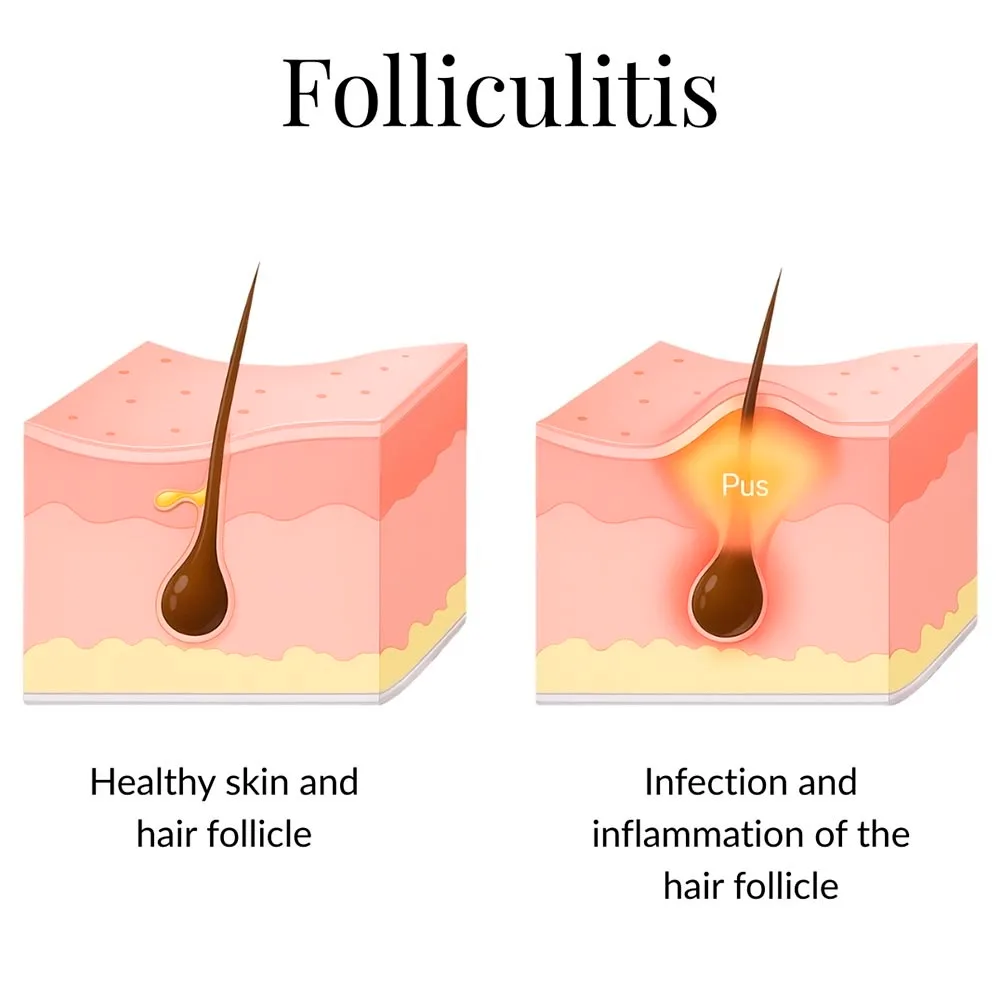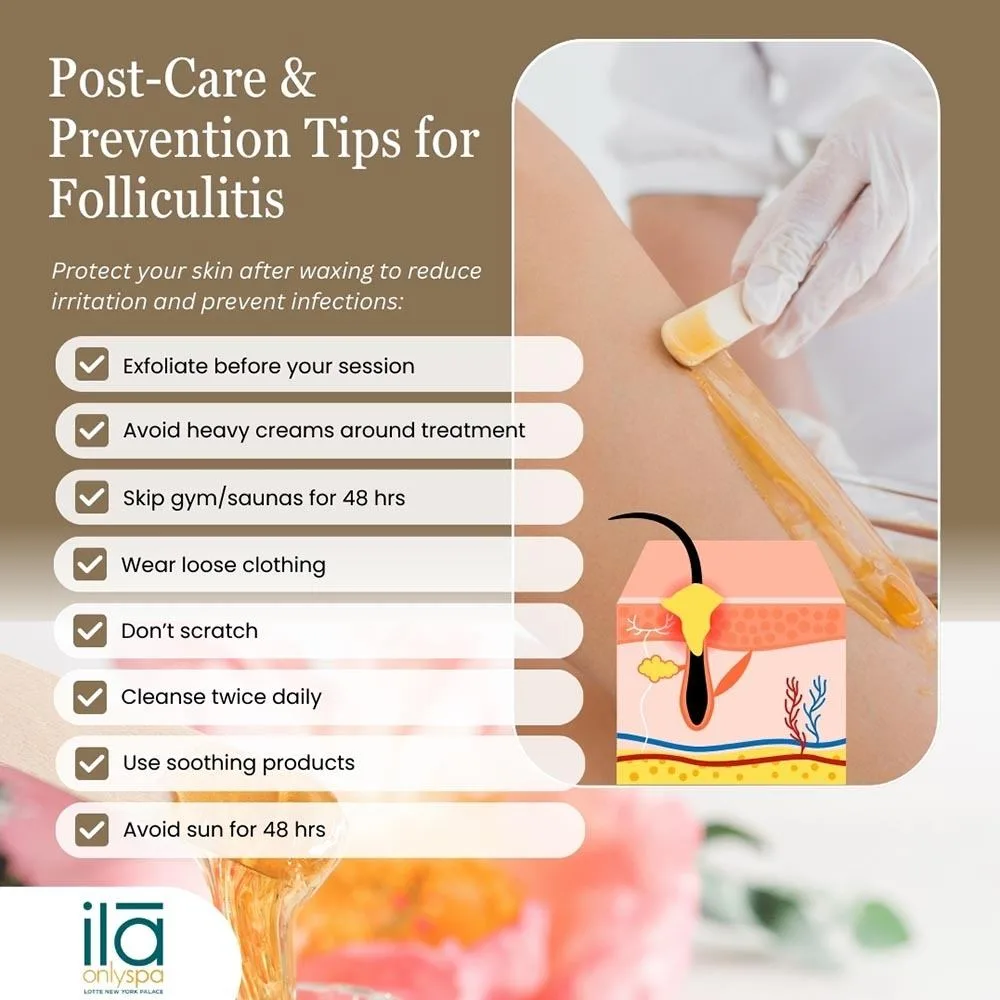Table of contents
While it is usually harmless and temporary, folliculitis can be uncomfortable if it is not prevented or treated timely. At ila Only Spa, our experienced estheticians offer the best grooming services with premium options, prioritizing your safety and well-being at all times. They understand your need to look and feel good at all times and provide a seamless waxing experience to ensure you enjoy clean, smooth, and healthy skin after hair removal treatment, without any side effects.
 Waxing is a simple yet one of the most popular and effective hair removal methods that produces longer-lasting results than shaving. Some people experience skin sensitivity after waxing, which subsides quickly. However, some people can end up with bumps after Brazilian wax treatments and other waxing services, which is often a sign of folliculitis, a skin condition that develops due to inflammation.
Waxing is a simple yet one of the most popular and effective hair removal methods that produces longer-lasting results than shaving. Some people experience skin sensitivity after waxing, which subsides quickly. However, some people can end up with bumps after Brazilian wax treatments and other waxing services, which is often a sign of folliculitis, a skin condition that develops due to inflammation.
Follicles are the tube-shaped structures that support the hair root. Bacteria, fungi, or ingrown hairs are typically the primary causes of folliculitis, but shaving, waxing, acne, excessive sweating, or blocked pores, and compromised immune systems can also increase its risk.
Read on to understand what folliculitis is, why it occurs, and what steps you can take to reduce the risk of developing these bumps and other symptoms after a waxing session.
What Is Folliculitis?
Folliculitis is the inflammation of the hair follicles, the tiny pockets from which hairs grow. It occurs when the hair follicles become irritated, inflamed, or infected after waxing. As the hair gets pulled from the root, it leaves the follicle temporarily exposed and vulnerable to bacteria, fungi, or external irritants, often appearing as small red bumps or white-headed pimples around hair follicles.
It is a type of skin reaction common in sensitive areas such as the bikini line, underarms, face, chest, and back. Sometimes it can affect the legs too.

What Does Folliculitis Look Like?
Symptoms of folliculitis may include:
- Flesh-colored bumps or pimples around a hair follicle
- Small pimples that resemble acne
- Pus-filled blisters that break open and become crusty
- Itching or burning sensation in the affected area
- Tenderness, pain, or discomfort to the touch
- Hair loss or scarring in severe or prolonged cases
- Redness, darkness, or hyperpigmentation of the skin in chronic cases
In some cases, bumps are the only sign of folliculitis. If you develop bumps after a Brazilian or any other type of waxing, you may not experience any other symptoms. Many people experience mild itching and tenderness too. Knowing the potential signs can help you seek timely care and prevent infection.
Common Causes of Folliculitis After Waxing
While waxing is a safe and effective hair removal method, it can occasionally lead to folliculitis.
Reasons include:
- Bacteria: Waxing opens up hair follicles temporarily. If bacteria, such as Staphylococcus aureus, get into the open pores, they can trigger an immune system response, causing infection and inflammation.
- Dead skin in the follicles: Accumulation of dead skin in the follicles can also result in folliculitis after waxing. The dead skin causes blockage and inflammation directly, or it can lead to ingrown hairs, which can irritate the follicles as they grow.
- Friction from clothing: Wearing tight underwear or clothing immediately after waxing can irritate the skin, trap sweat and bacteria, and result in follicle inflammation.
- Excessive sweating: People who sweat a lot for any reason can end up with folliculitis. Sweat creates a warm, moist environment for bacterial growth and also clogs the follicles.
- Poor hygiene or aftercare: Failing to follow proper post-wax hygiene or aftercare increases the chances of developing follicle infection.
- Sensitive skin: People with sensitive skin, or eczema, are more vulnerable to folliculitis.
- Medical conditions: People with diabetes and other conditions that affect the immune system are at a higher risk of acquiring bacterial infections that lead to folliculitis.
If you have sensitive skin or a medical condition, it is important to tell your aesthetician before the waxing session. They will ensure the right skincare approach and make adjustments to ensure your treatment is both safe and comfortable. A timely and proactive approach can help you enjoy luxury spa services comfortably.
Post-Care and Prevention Tips for Folliculitis
Aftercare is a crucial part of preventing folliculitis and other skin issues. Proper post-care can reduce inflammation, infections, and irritations.
Follow these expert-recommended tips to help prevent symptoms of folliculitis:
- Exfoliating before your waxing session
- Avoiding heavy creams that can clog pores before and after treatment
- Skipping the gym and saunas, as sweat can clog pores and provide a breeding ground for bacteria
- Wearing loose-fitting clothing during the treatment and the first few days afterward
- Avoiding scratching, as it can encourage bacterial presence or worsen irritation
- Keeping the waxed area clean by cleansing at least twice a day
- Applying soothing products recommended by your aesthetician
- Avoiding sun exposure, especially 48 hours after waxing
Preventing inflammation and irritation of your skin is key to ensuring a smooth and comfortable waxing experience and enjoying glowing skin in the following days. With the right aftercare, you can minimize complications, and reduce the risk of bumps or folliculitis.
Related article: Should I Exfoliate Before Waxing?
Treating Folliculitis and Post-Waxing Bumps
Here are some tips on soothing your skin and treating these bumps effectively:
- Apply a warm compress: Use a clean, warm cloth on the affected area to open pores, improve blood flow, and speed up healing.
- Cleanse with antibacterial soap: Keep your skin clean by gently washing the area with a mild antibacterial or antiseptic lotion with lukewarm water. Do not scrub harshly, as it can further irritate the skin.
- Use topical antibacterial cream: Bacterial folliculitis can be treated with topical antibacterial cream. However, consult your doctor before using prescription treatments.
- Avoid touching or popping pimples: Do not touch, scratch, or squeeze these pimples as it can worsen the infection and increase the risk of scarring. Use recommended soothing products to protect your skin.
- Apply post-wax soothing products: A cooling post-wax gel with ingredients like menthol or aloe vera can reduce inflammation and speed up skin recovery.
Most cases of post-waxing folliculitis clear up within a few days. However, if your skin condition worsens or does not improve with home treatments, consult your waxing therapist or a dermatologist. The best way to prevent folliculitis from waxing is to always visit a licensed expert who works in a clean, safe environment and follows strict sanitization protocol. They can also provide recommendations and additional tips for promoting healthy skin.
Read more: What to Know about How Long Does Waxing Last
Folliculitis may occur as a side effect of waxing, but it is typically mild and temporary and can be prevented and managed with hygiene practices and gentle aftercare post-wax. Call ila Only Spa for the best skin grooming experience that combines luxury with expert guidance. Our trained estheticians ensure you get smoother, cleaner skin, and focus on minimizing the risk of irritation or infection after waxing session.
